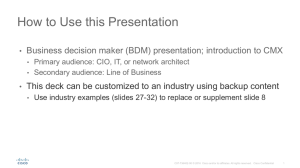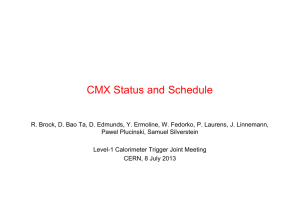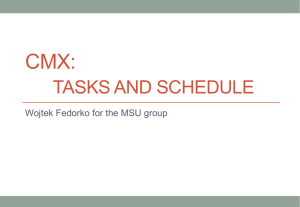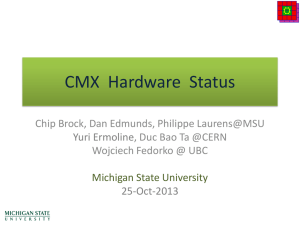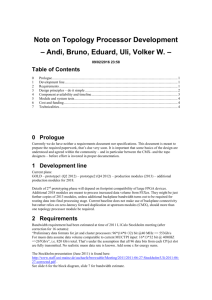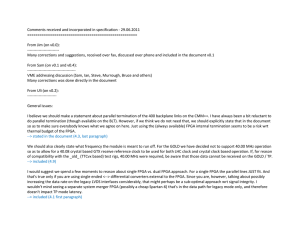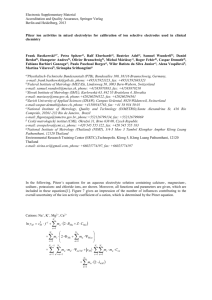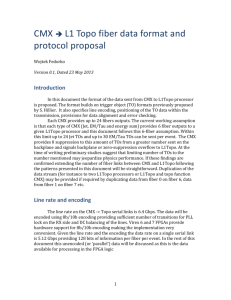20130408_TDAQweek_Yuri
advertisement
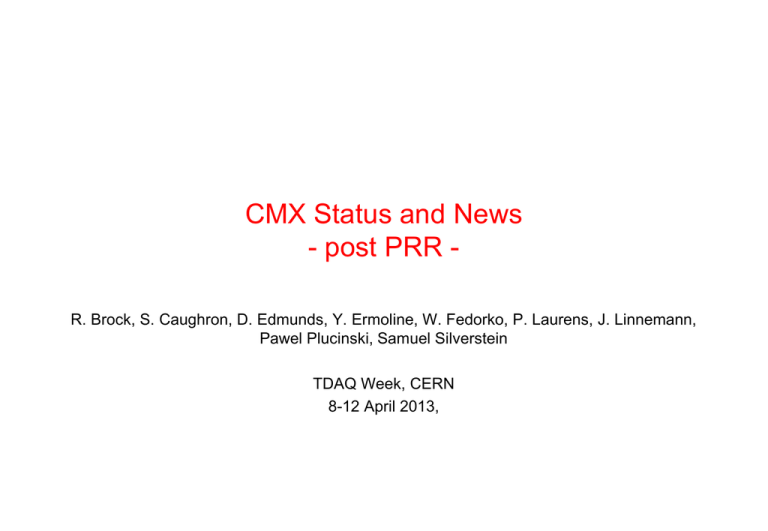
CMX Status and News - post PRR R. Brock, S. Caughron, D. Edmunds, Y. Ermoline, W. Fedorko, P. Laurens, J. Linnemann, Pawel Plucinski, Samuel Silverstein TDAQ Week, CERN 8-12 April 2013, CMX scope (Phase 0 item) 1/8 pre PRR CMX The CMX must: Be able to perform all tasks currently handled by any CMM. Be able to perform these CMM tasks at higher input and output line rates. Provide more computing power to support additional algorithms. Provide new functionality to send a raw or processed copy of its inputs out optically. Provide optional functionality to perform Topological Processing on CMX data. 2/8 PRR (07.03.13) – outcome (1) Compatibility with existing L1Calo crate Infrastructure Avago MiniPOD component height MiniPOD clearance verified at CERN No front-panel access to the CompactFlash card Moving Compact Flash module to the front panel Board Functionality Required output from the TTCDec to the BF FPGA L1_Accept, BC_Reset, 40.08 MHz clock from an LHC locked crystal PLL. CANbus monitoring should also include currents Adding an analog multiplexer to one microprocessor analog input All single-ended signal lines on the backplane have 60 ohms impedance 400 backplane processor input traces are now 60 Ohm Front-panel outputs for the deskew1 and deskew2 clocks Two pins in the bottom connector on the CMX front panel can be used to supply a copy of clock signal(s) OR to send out S-Link Busy signals 3/8 PRR (07.03.13) – outcome (2) Interfaces with connected systems No 40.000 MHz crystal clock for G-Link readout to L1Calo RODs Adding 40.000 MHz crystal oscillator to the CMX design CMX to act as its own ROD, providing readout to DAQ and the ROIB using S-link protocol. Adding hardware support to make possible S-Link readout from the TP FPGA Replacement of 12-fiber MTP feedthrough with 48-fiber Reducing number of front-panel optical feed-throughs from 5 to 2 (Note: Most CMX cards use only the Base Function and thus can still use 1x or 2x simpler 12-fiber ribbons) Recommended to use 3.3V devices that are 5V tolerant CMX design was already using 5V tolerant 3.3V CMOS components for VME-- bus 4/8 MiniPOD clearance 5/8 CMX new layout 6/8 CMX further steps Draft report from the review (15.03.13) Note in reply to the draft report sent to review committee (03.04.13) All review actions addressed go-ahead for production? Efforts in parallel on 5 fronts: MSU – CMX design Raymond Brock, Dan Edmunds, Philippe Laurens CERN – VAT card testing Yuri Ermoline CMX software Seth Caughron UBC – BF FPGA firmware: IO Wojtek Fedorko Stockholm – BF FPGA firmware: zero-suppression, thresholding Pawel Plucinski, Samuel Silverstein 7/8 CMX development schedule 2013: Prototype fabrication and testing at MSU Mar: Prototype Readiness Review Apr-Jun:Prototype fabrication Jun: Test rig checked out at MSU Jun-Aug: CMM firmware ported on CMX Sep-Dec: Basic tests for backward compatibility at MSU 2014: Full prototype testing at CERN / final fabrication Jan-May: Jan-Sep: May-Sep: Sep-Dec: Full prototype tests in test rig at CERN CMX firmware development and test Fabricate and assemble full set of CMX modules Test in the USA15 L1Calo system during shutdown 2015: Final commissioning in the L1Calo trigger system in USA15 Jan-Mar: Final commissioning 8/8
